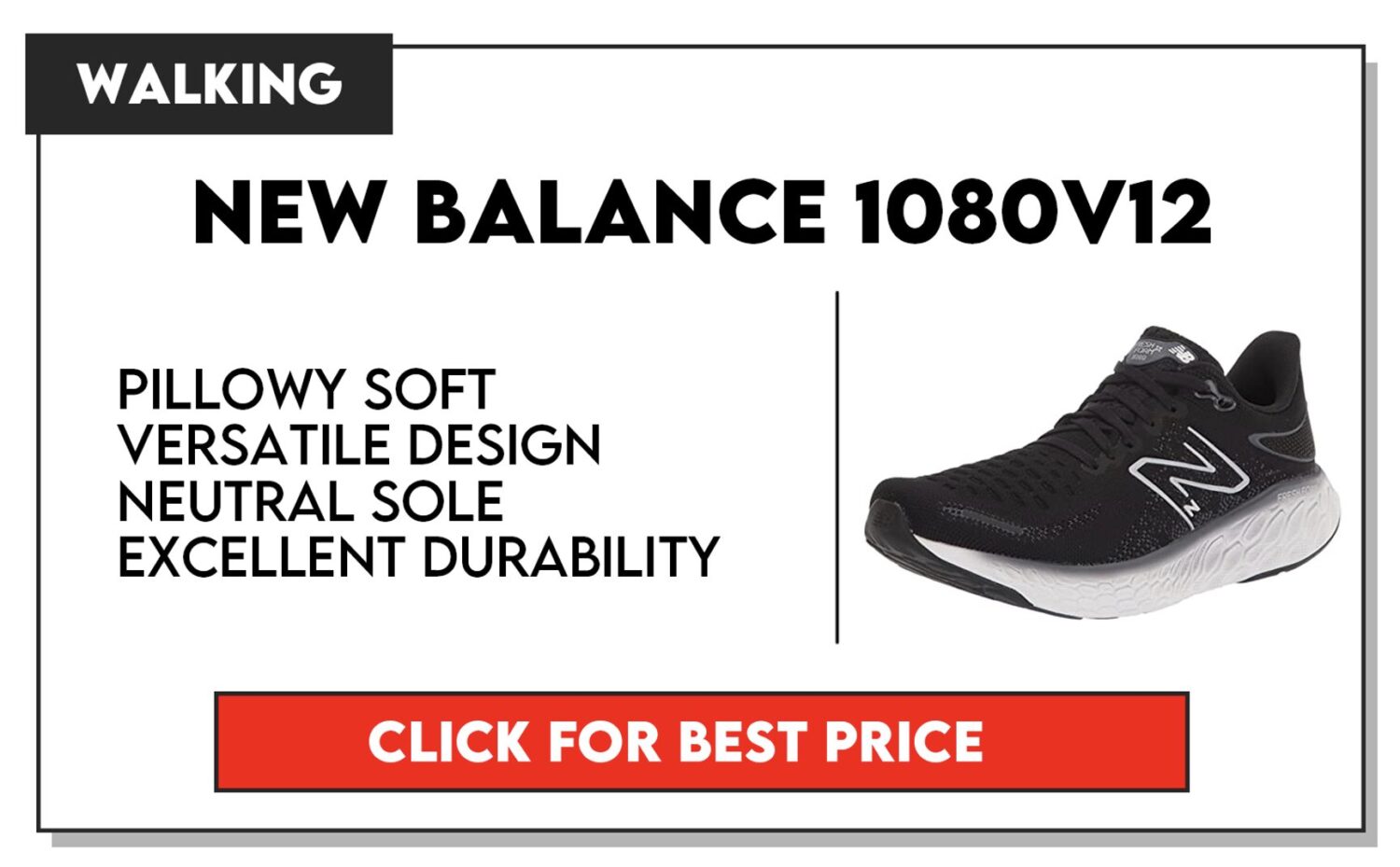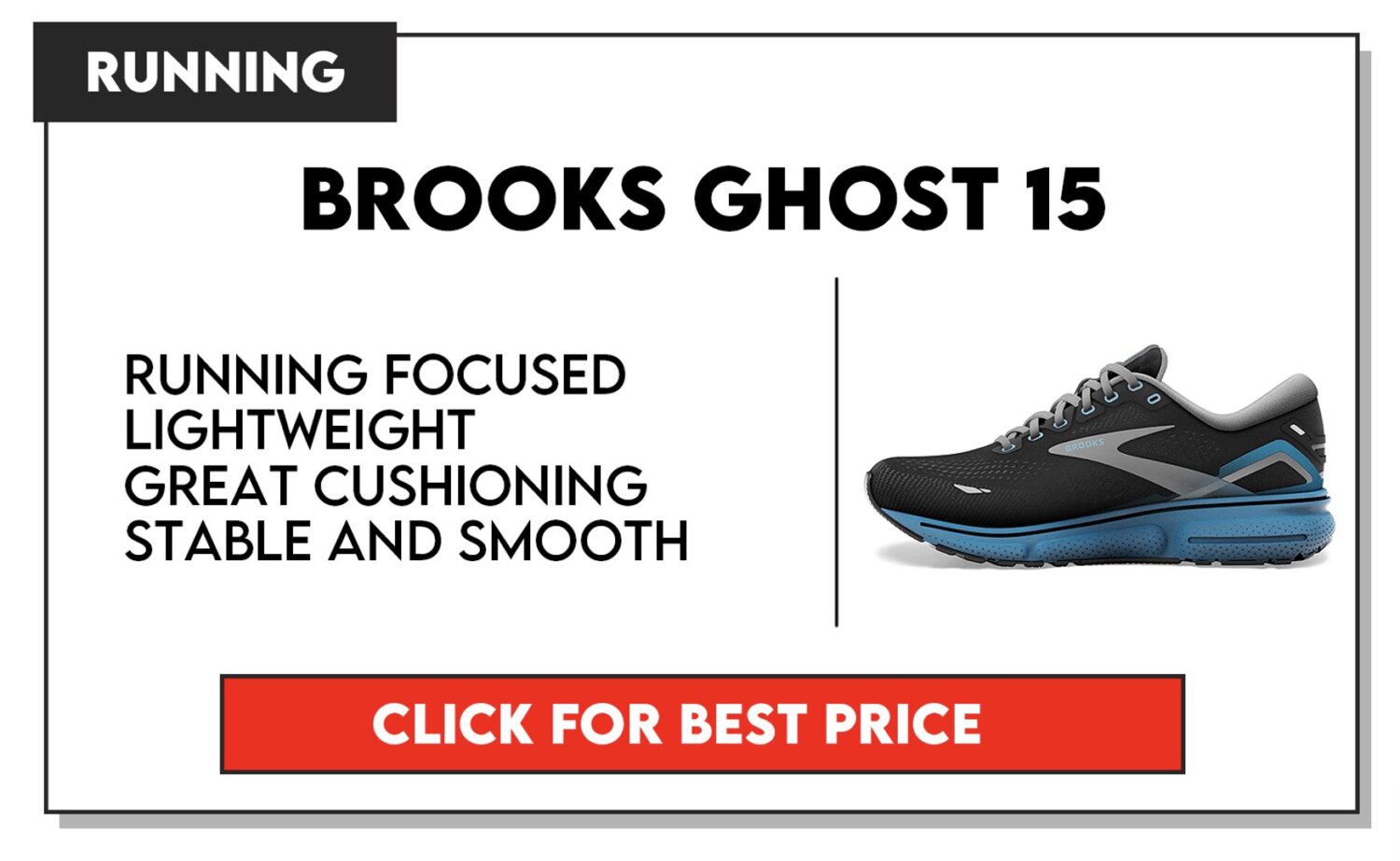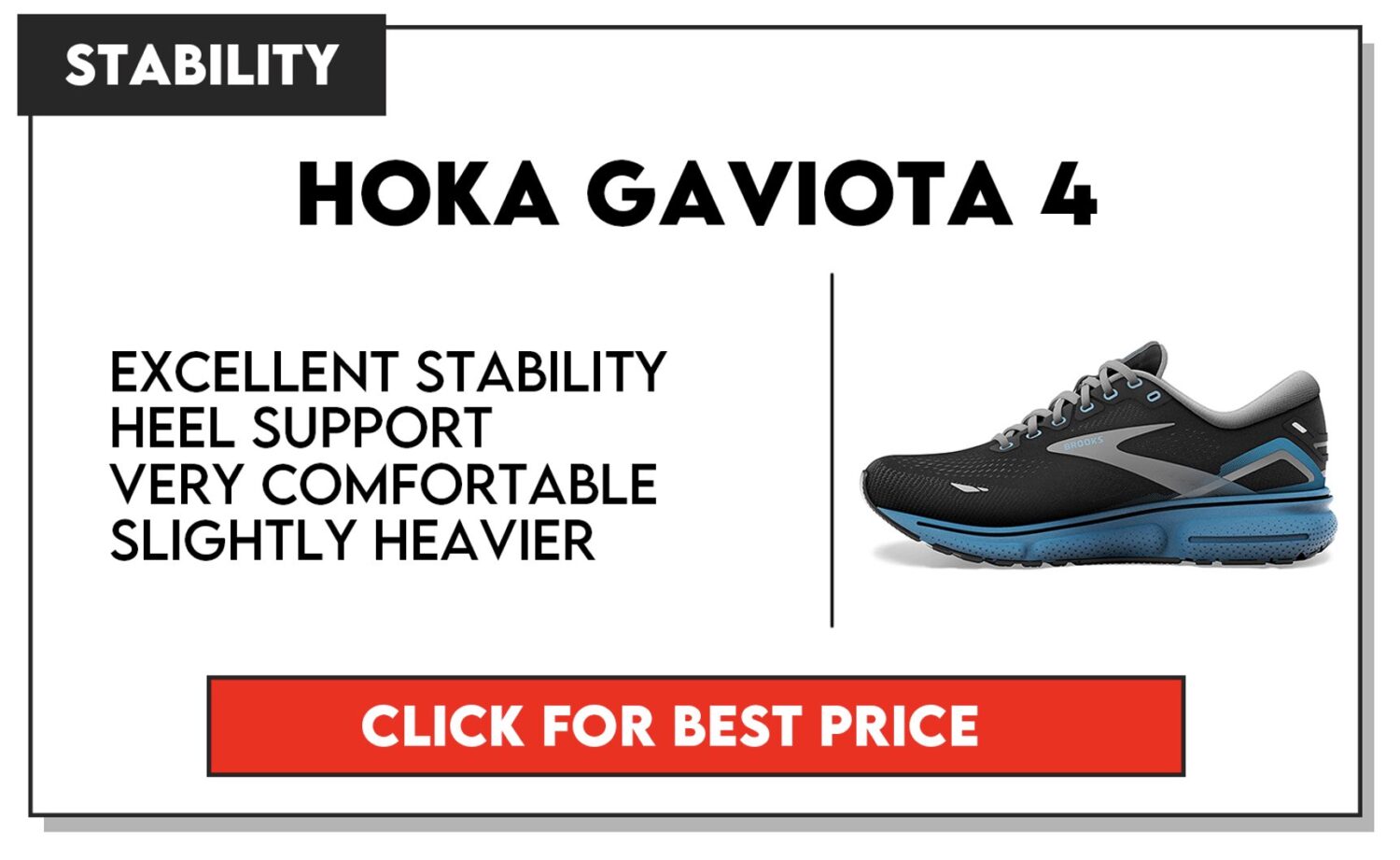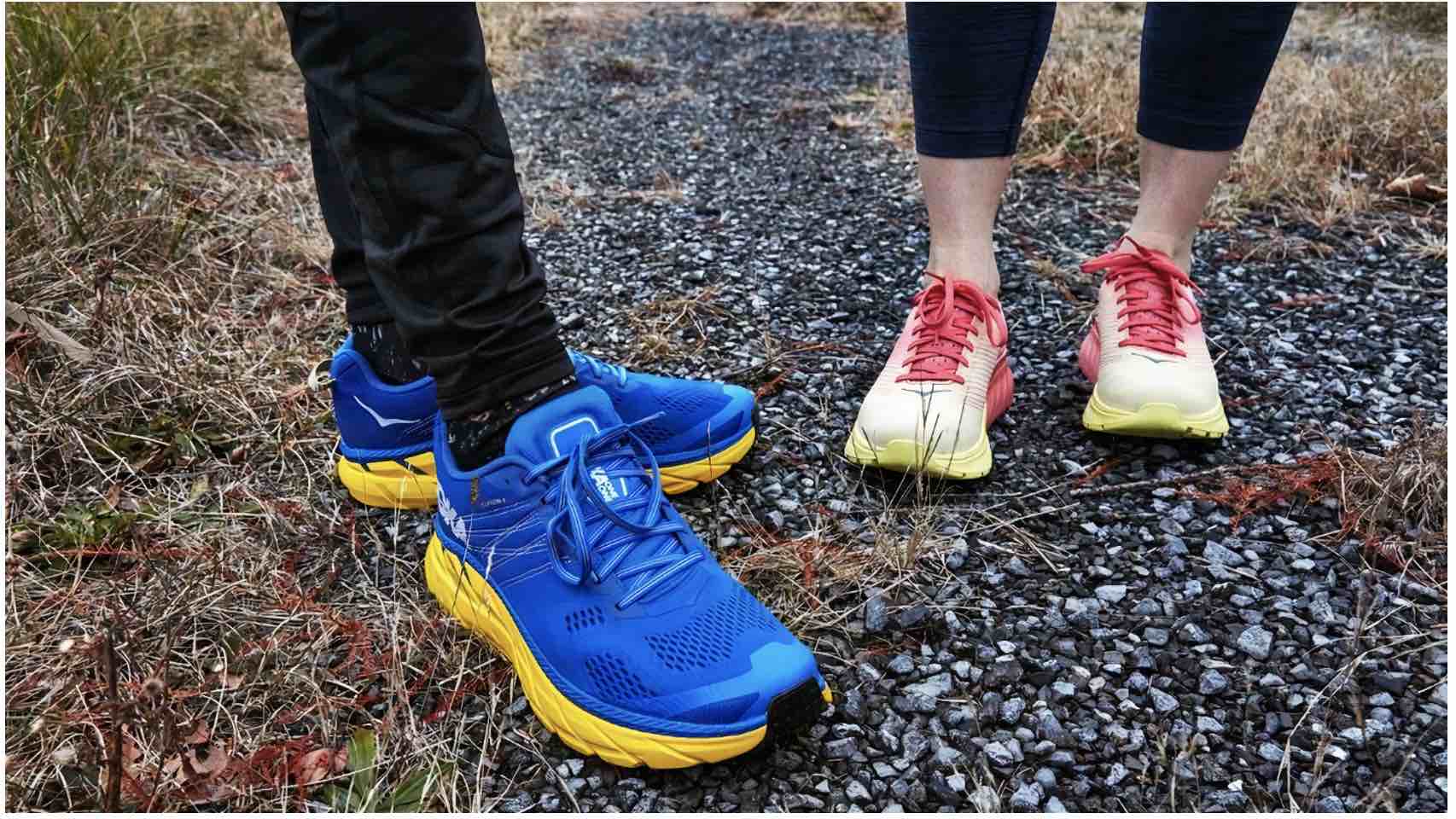
Morton’s neuroma can be a painful and debilitating condition, but choosing the right footwear can make a significant difference in managing symptoms and improving comfort.
Today, we will outline the key features to look for in shoes that support and protect your feet, helping you find relief from Morton’s neuroma pain. Shoe design is essential for those affected by Morton’s Neuroma, a painful condition often causing a burning sensation between the third and fourth toe.
Our Picks for the Best Shoes for Morton’s Neuroma
- Hoka Bondi 8 – Best overall
- New Balance 1080v12 – Best walking shoes
- Brooks Ghost 15 – Best running shoes
- Hoka Gaviota 4 – Best for Stability
The Harvard Center for Health and the Global Environment is committed to improving global health outcomes. The Harvard CHGE assembles a multi-disciplinary team of experts in diverse fields to address some of the world’s most pressing health challenges. Experts from CHGE have medically evaluated this list.
Hoka Bondi 8 – Best Overall
Our top pick for the best shoes for Morton’s Neuroma is the Hoka Bondi 8 Shoes. These shoes are renowned for their superior cushioning and comfort.
The Bounce 8 cushioning absorbs the impact of walking and running, providing a critical feature for those with Morton’s Neuroma. Morton’s Neuroma occurs when the tissue around the nerves leading to the toes thickens, resulting in burning sensations and discomfort. It’s an issue often exacerbated by ill-fitting shoes, particularly high heeled shoes which place undue stress on the forefoot area.
The Hoka Bondi 8, a fitness shoe from one of the leading shoe brands, counters this problem with a 4mm heel drop, reducing the pressure on the forefoot and making them the ideal shoes for Morton’s Neuroma. The neutral sole offers enough support, especially good arch support, crucial for those with foot conditions like Morton’s Neuroma or plantar fasciitis.
New Balance 1080v12 – Best for Walking
Claiming the runner-up spot on our list of the best shoes for Morton’s Neuroma is the New Balance 1080v12. These shoes shine as a top choice for those experiencing this foot condition due to their exceptional comfort and adaptability. Both designed for running and walking, they suit active individuals perfectly.
The Fresh Foam X cushioning in these shoes supplies the critical arch support needed when managing Morton’s Neuroma. Also, the 8mm heel drop and neutral sole, characteristic of the 1080v12, reduce forefoot pressure.
Their stylish appearance sets the New Balance 1080v12 apart in the list of shoes for Morton’s Neuroma. Available in various colors, they blend style and function effortlessly, making them ideal for daily wear. Whether running errands, hitting the gym, or merely enjoying a jog, you can count on these shoes to provide the comfort and support required to effectively manage Morton’s Neuroma pain.
These shoes don’t just prioritize comfort and style; they also score highly on durability. This makes them the right shoe choice for individuals who need shoes that will last, a feature that’s as crucial as having a wide enough toe box or cushioned soles.
Brooks Ghost 15 – Best Running Shoes
Rounding out our selection for the best shoes for Morton’s Neuroma is the Brooks Ghost 15 Shoes. These are an excellent choice if you’re searching for comfort and durability in one package. Designed with running in mind, these shoes cater especially well to runners experiencing Morton’s Neuroma discomfort.
The Brooks Ghost 15 boasts of BioMoGo DNA and DNA LOFT cushioning. This shoe feature ensures remarkable comfort and support, particularly appreciated by those with Morton’s Neuroma. They also have an 11mm heel drop and a neutral sole, significantly reducing pressure on the forefoot.
Durability is another standout feature of these shoes. They are built to withstand daily wear and tear, making them an ideal choice for running and walking. Available in various colors, the Brooks Ghost fits well for everyday activities, demonstrating how the correct shoes can effectively help manage foot problems like Morton’s Neuroma.
When dealing with or seeking to prevent developing Morton’s Neuroma, choosing shoes with a roomy toe box, good arch support, and cushioned soles is key. The Brooks Ghost 15 Shoes offer these features and more, making them a leading contender among the best shoes for Morton’s Neuroma.
Hoka Gaviota 4 – Best for Stability
Seeking a pair of shoes that lend stability and support to alleviate Morton’s Neuroma discomfort? The Hoka Gaviota 4 Shoes emerge as an excellent choice. These shoes have been crafted meticulously with a range of foot-friendly features to provide superior comfort and support.
These shoes incorporate a 5mm drop, J-Frame support, and the unique Gaviota 4 comfort cushioning. The J-Frame technology is crucial in reducing excess pronation during the gait cycle. This feature is especially beneficial for those with flat feet, a condition often associated with Morton’s Neuroma. The reduction in pronation subsequently minimizes the pressure on the forefoot, making these shoes ideal for those struggling with Morton’s Neuroma.
Further enhancing the shoe’s comfort factor is the Gaviota 4 cushioning, providing exceptional comfort and support. Coupled with a wide-toe box and 5mm cushioning, these shoes help to prevent compression and irritation of Morton’s Neuroma, a painful condition affecting the foot.
Beyond their comfort and support, the Hoka Gaviota 4 Shoes are stylish and available in various colors, making them an excellent choice for wide-fitting shoes.
More About Morton’s Neuroma
Morton’s neuroma is a painful foot condition that occurs when the nerve that runs between the metatarsal bones in the forefoot becomes irritated, compressed, or damaged.
This condition most commonly develops between the third and fourth toes and is significantly more prevalent in women than men, with an incidence rate 8 to 10 times higher in women.
Symptoms of Morton’s Neuroma:
Individuals with Morton’s neuroma may experience a range of symptoms, including:
- Numbness or a “pins and needles” sensation in the toes, often accompanied by a loss of sensation that feels like heel spurs.
- Burning pain in the ball of the foot may radiate into the toes, particularly when wearing shoes.
- Pain while running, especially during the push-off phase from the starting block
- Increased pain when wearing high heels or tight, narrow shoes can compress the toe bones and further irritate the affected nerve.
Morton’s neuroma symptoms can be exacerbated by certain footwear choices or activities that place excessive pressure on the nerve.
Individuals with this condition must seek medical advice and consider appropriate footwear and treatment options to alleviate pain and manage symptoms effectively.
Causes of Morton’s Neuroma
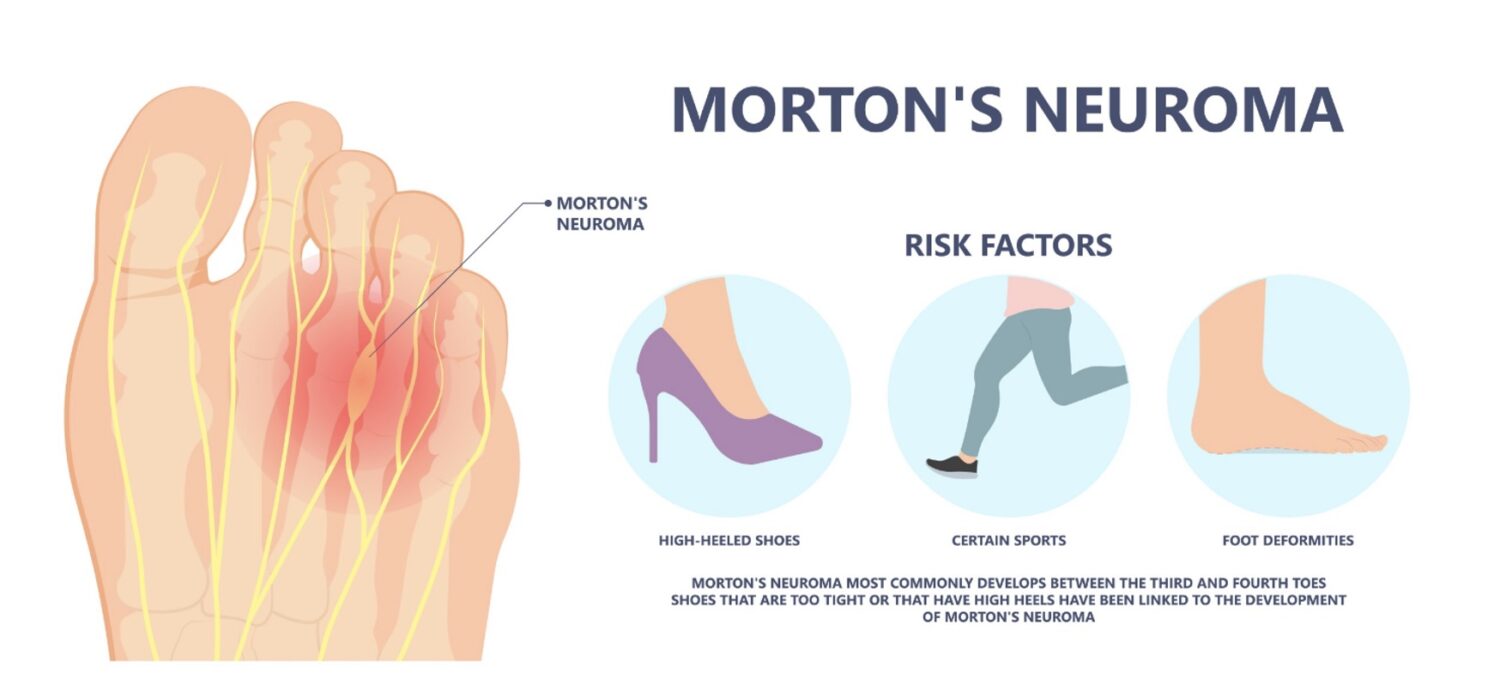
Morton’s neuroma can be caused by a variety of factors, including:
- Poorly fitted footwear: Shoes with a tight and narrow toe box can cause the nerve to become entrapped, leading to pain and discomfort.
- High-heeled shoes: These types of shoes place the metatarsals under extreme pressure, and have poor arch support, which can contribute to the development of Morton’s neuroma.
- Abnormal pronation: In cases of significant motion between the third and fourth metatarsals due to abnormal pronation, the nerve that runs between them can become irritated.
Treatment Options for Morton’s Neuroma
Initial therapies for Morton’s neuroma are nonsurgical and can involve one or more of the following treatments:
- Changes in shoes: Avoid high heels or tight shoes, and wear wider shoes with lower heels and a soft sole. This allows the bones to spread out and may reduce pressure on the nerve, giving it time to heal.
- Orthotics: Custom shoe inserts and pads help relieve irritation by lifting and separating the bones, reducing the pressure on the nerve.
- Injections: One or more corticosteroid injections can reduce the swelling and inflammation of the nerve, providing some relief.
- Massage: Massaging the affected area can offer temporary relief from discomfort.
- Weight Loss: As you lose weight, the bones and joints in your feet will experience less wear and tear, and it can provide pain relief.
Several studies have shown that a combination of roomier, more comfortable shoes, nonsteroidal anti-inflammatory medications, custom foot orthoses, and cortisone injections provide relief for over 80% of people with Morton’s neuroma.
If conservative treatments do not alleviate symptoms, your physician may discuss surgical treatment options.
Shoes That Work With You, Not Against You
When shopping for Morton’s neuroma shoes, aim to try them on in the evening, as your feet tend to be larger at the end of the day. Look for shoes with at least a half-inch of toe room and stand, walk, and lightly jog in them to assess their fit and support.
Prioritize Arch Support
Whether you lead an active lifestyle or not, investing in high-quality shoes with adequate arch support is crucial. Arch support helps offset pressure and strain by acting as a shock absorber, particularly if you have abnormal posture, an inadequate gait, or other high-risk factors for foot conditions.
Find the Right Size
Did you know that the size of your right foot often differs from your left foot? To minimize strain on the connective tissues of your feet, it’s essential to wear consistent shoes that accommodate any size discrepancies. If your shoe size differs by more than 1½ sizes, consider custom-made shoes or purchasing mismatched size footwear. Consult an expert to accurately evaluate your foot size if you experience pain or discomfort.
Choose Wide Toe Box Shoes
Wide-toe box shoes prevent direct impact pressure on the forefoot, as they stop metatarsal bones from overriding one another. Ensure your shoes have a sufficiently wide toe box to accommodate your feet when swelling most likely occurs at the end of the day.
Opt for Low or Zero Drop Shoes
Select shoes with a completely flat design to avoid putting pressure on the bones in the ball of your feet where Morton’s neuroma is located.
Consider Custom Orthotics
Custom orthotics can help correct stance and gait issues while providing cushioning to inflamed connective tissue by offsetting pressure. Speak to a professional about whether custom orthotics may be a beneficial addition to your footwear.
Seek Adjustable Fitting Shoes
Shoes that are too narrow or too roomy can negatively impact foot stability and integrity. Opt for footwear with adjustable fittings like laces or straps to tailor the fit according to your comfort needs.
Know When to Replace Your Shoes
Recognizing when to retire your shoes is crucial for managing Morton’s neuroma pain. Holding onto shoes with worn-out heels and tread can exacerbate your condition and increase discomfort. Be mindful of your shoes’ condition and replace them when necessary.
Following these recommendations and guidelines, you can find the right footwear to help manage Morton’s neuroma pain and discomfort.
Keep in mind that shoes alone are not a cure and should be combined with appropriate conservative treatments or procedures as needed. Consult a healthcare professional for personalized advice on managing your Morton’s neuroma symptoms.
Final Thoughts
Finding the best shoes for Morton’s Neuroma can significantly improve your comfort and quality of life.
Choosing shoes with features tailored to this condition is essential, such as a wide toe box, ample shock absorption, proper metatarsal support, and a low ball heel ratio. Shoes that offer a narrow heel and a proper fit can also help to alleviate pressure on the foot and reduce pain.
Remember, the primary goal when making a shoe choice for Morton’s Neuroma is to prevent further discomfort and facilitate healing. To achieve this, you need to consider a range of shoe features and ensure they’re specifically designed to meet your needs.
Opt for something that provides support and cushioning and helps reduce forefoot overloading, a mechanism often associated with Morton’s Neuroma.
Avoid old shoes that may not provide the necessary support or comfort, potentially leading to more pain or other musculoskeletal defects. Make sure your chosen shoes are fit for purpose, whether that’s walking, running, or general wear.
You’re investing in your foot health and well-being by choosing the right shoes for Morton’s Neuroma. This decision plays a significant role in treating Morton’s Neuroma and minimizing the impact of this condition on your everyday life.
As always, consult a healthcare professional for personalized advice concerning Morton’s Neuroma and the most suitable footwear options for you.
Advertising disclosure: We may receive compensation for some of the links in our stories. Thank you for supporting LA Weekly and our advertisers.


